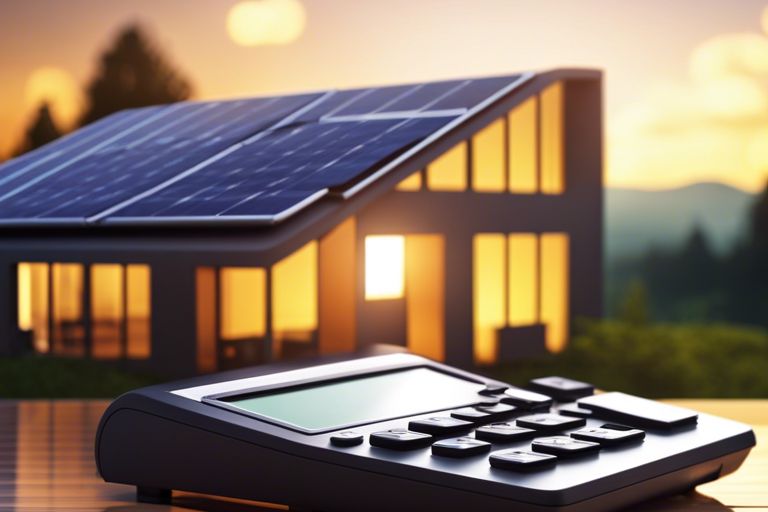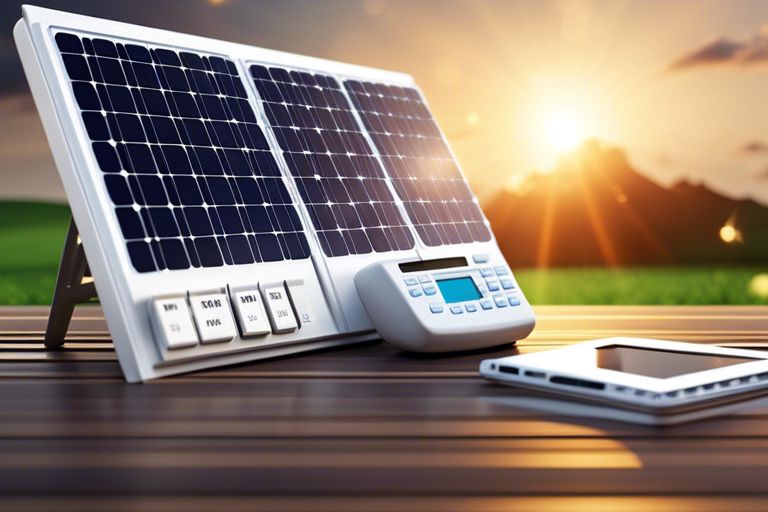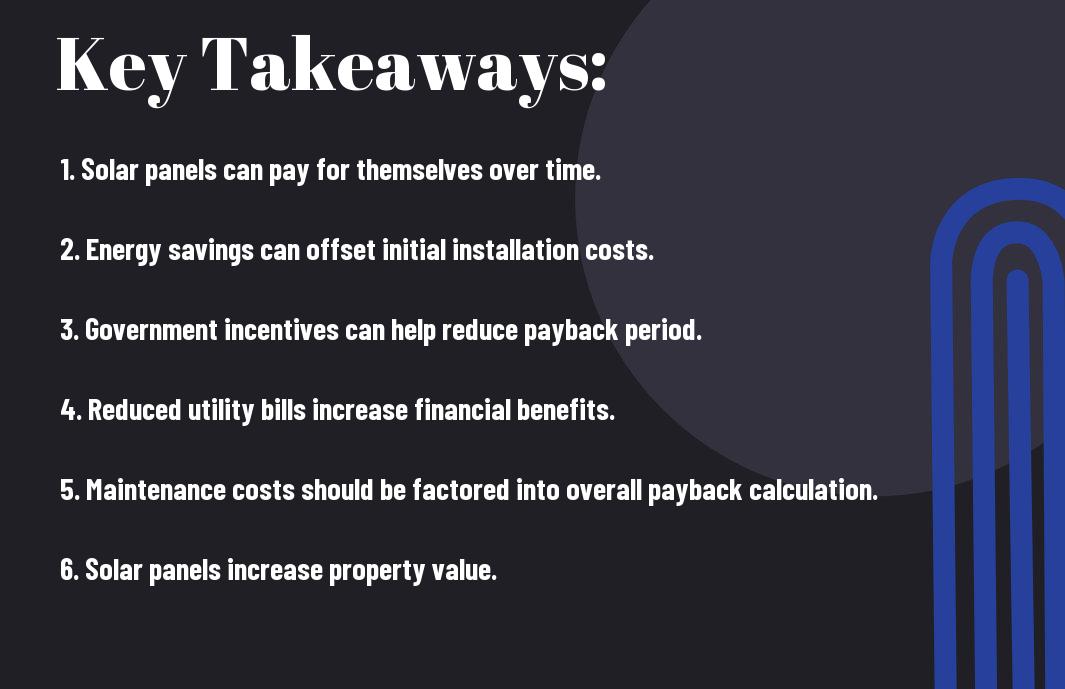Efficiency is key when considering if solar panels pay for themselves. You may be wondering if the initial investment in solar panels is truly worth it in the long run. Let’s explore into the financial aspects and environmental benefits of solar panel installation to determine if going solar is a smart decision for your wallet and the planet.
Key Takeaways:
- Financial Savings: Solar panels can help homeowners save money on their energy bills over time by generating their own electricity.
- Payback Period: The payback period for solar panels can vary based on factors like location, energy usage, and system cost.
- Government Incentives: Many governments offer incentives, such as tax credits or rebates, to help offset the cost of installing solar panels.
- Long-Term Investment: Solar panels are a long-term investment that can increase the value of a property and offer energy savings for many years.
- Environmental Benefits: In addition to financial savings, solar panels also contribute to reducing carbon emissions and dependence on fossil fuels.
The Economics of Solar Panels
Initial Investment Costs
One of the main considerations when it comes to solar panels is the initial investment costs. Installing solar panels on your property requires a significant upfront investment. This includes the cost of the panels themselves, installation fees, and any additional equipment needed to connect the system to your home.
Long-term Savings and Benefits
Investment in solar panels can lead to long-term savings and benefits. Over time, the energy generated by the solar panels can offset your electricity bills, leading to potentially significant savings. Additionally, if your solar panels generate more energy than you use, you can sell the excess back to the grid in some areas, providing you with an additional source of income.
Moreover, solar panels can increase the property value of your home. Homes with solar panels are attractive to environmentally-conscious buyers and may be able to fetch a higher price on the market when you decide to sell.

The Role of Government Incentives
The Are Solar Panels Worth It? energy landscape is changing, with more homeowners like you considering solar panels. One significant factor influencing the decision to invest in solar panels is the role of government incentives.
Tax Credits and Rebates
To further incentivize the adoption of solar panels, various governments offer tax credits and rebates. These financial incentives can help offset the initial investment cost of installing solar panels on your property. Tax credits allow you to deduct a portion of the cost of your solar energy system from your federal taxes, while rebates provide a direct cash incentive based on the system’s size and performance.
Net Metering and Feed-in Tariffs
To encourage solar energy production, many regions implement net metering and feed-in tariffs. Net metering allows you to send excess electricity generated by your solar panels back to the grid in exchange for credits on your energy bill. On the other hand, feed-in tariffs involve the government paying you for the electricity your solar panels produce, incentivizing you to generate more renewable energy.
Another critical aspect of net metering and feed-in tariffs is that they can help you offset the cost of your electricity usage, potentially making your solar panels an even more financially attractive investment in the long run.
Assessing Your Energy Needs
Evaluating Your Energy Consumption
To accurately assess whether solar panels will pay for themselves, you first need to evaluate your energy consumption. Look at your past energy bills to determine how much electricity your household uses on average. Consider factors such as seasonal variations and any future changes in your lifestyle that may impact your energy needs.
Determining the Right System Size
To ensure that your solar panel system pays for itself, you must determine the right system size based on your energy consumption. Factors such as the orientation of your roof, the amount of sunlight your location receives, and any shading from nearby structures or trees will impact the size of the system you need.
With the advancements in solar technology, it’s now easier to customize a solar panel system to meet your specific energy needs. By accurately determining the right system size, you can maximize the financial benefits of your solar investment and ensure that your panels pay for themselves in the long run.
The Payback Period
All calculations regarding the payback period for solar panels ultimately lead to the Break-Even Point. This is the point at which your solar panel system has generated enough energy to cover the initial cost of installation. To determine the Break-Even Point, you need to consider factors such as the upfront cost of the system, the energy savings it generates, any financial incentives or rebates, and the rate at which utility prices are increasing.
Calculating the Break-Even Point
BreakEven As you calculate the Break-Even Point for your solar panel system, you will need to take into account the total cost of installation, including equipment, labor, permits, and any additional components like batteries or monitoring systems. You will also need to estimate the amount of energy your system will produce and the savings you will accrue on your utility bills over time.
Factors Affecting the Payback Period
- The cost of solar panels and installation
- The amount of sunlight your location receives
- Local electricity rates
- Available financial incentives or rebates
Period The payback period for solar panels can vary significantly based on these factors. For example, if you live in an area with high electricity rates and ample sunlight, your payback period may be relatively short. Conversely, if you reside in a location with lower electricity costs and limited sun exposure, it may take longer to recoup your initial investment. The key is to consider these factors carefully and evaluate how they may impact your individual payback period.
- The payback period ultimately depends on your unique circumstances
Real-World Examples
Residential Solar Panel Installations
To truly understand if solar panels pay for themselves, you need to look at real-world examples. Despite the initial investment, many homeowners find that residential solar panel installations can indeed save you money in the long run. By generating your own electricity, you can reduce your dependence on the grid and lower your monthly utility bills. Additionally, with incentives such as tax credits and net metering programs, you can recoup some of the upfront costs.
Commercial and Industrial Applications
To assess the financial viability of solar panels, you should also consider commercial and industrial applications. Any business looking to cut costs and reduce its carbon footprint can benefit from investing in solar energy. Large commercial buildings, factories, and warehouses can see significant savings on electricity bills by harnessing the power of the sun. These savings can then be reinvested back into the business, making it a smart long-term investment.
Applications of solar panels in commercial and industrial settings go beyond just cost savings. By installing solar panels, businesses can demonstrate their commitment to sustainability, attract environmentally-conscious customers, and enhance their brand image.

Overcoming Common Objections
Addressing Upfront Costs Concerns
Costs can often be the first concern when considering solar panels. While the initial investment may seem significant, it’s important to look at the long-term benefits. Many government incentives and financing options are available to help offset these costs. In fact, some solar panel systems can pay for themselves within just a few years through energy savings and incentives.
Debunking Energy Output Myths
Upfront, you may have heard myths about solar panels not producing enough energy to make them worth the investment. However, advancements in technology have made solar panels much more efficient than in the past. Additionally, the amount of energy your panels produce depends on factors like location, panel orientation, and shading. By working with a reputable solar installer, you can ensure your system is optimized for maximum energy production.
For instance, did you know that even on cloudy days, solar panels can still generate electricity? While direct sunlight is ideal, solar panels can still produce energy on overcast days. So, don’t let misconceptions about energy output deter you from considering solar panels for your home.

Summing up
Drawing together the information presented in this article, it is evident that solar panels can indeed pay for themselves over time through energy savings and potential incentives. While the initial investment may seem steep, the long-term financial and environmental benefits can make them a worthwhile addition to your home or business. By carefully considering your energy needs, local incentives, and the long-term savings potential, you can make an informed decision about whether investing in solar panels is the right choice for you.
FAQ
Q: Do solar panels pay for themselves?
A: Yes, solar panels can pay for themselves over time through savings on electricity bills and potential incentives, such as tax credits and rebates. The exact payback period depends on various factors, including installation costs, energy consumption, local sunlight conditions, and available incentives.
Q: What factors determine how long it takes for solar panels to pay for themselves?
A: Several factors can influence the payback period of solar panels, such as the cost of installation, the amount of sunlight received in the location, the price of electricity, available incentives like tax credits or rebates, and the energy consumption habits of the household. Generally, the higher the energy costs and the better the sunlight conditions, the quicker the payback period.
Q: Are there any ways to accelerate the payback period of solar panels?
A: Yes, there are several strategies to shorten the payback period of solar panels. These include maximizing energy efficiency in the household to reduce overall energy consumption, taking advantage of available incentives and financing options, choosing high-quality solar panels with better efficiency ratings, and considering options like solar panel leasing or power purchase agreements.
